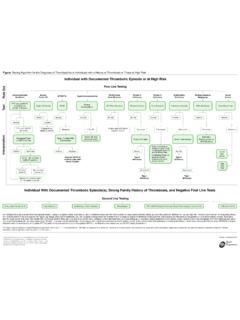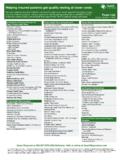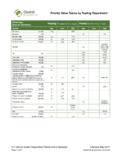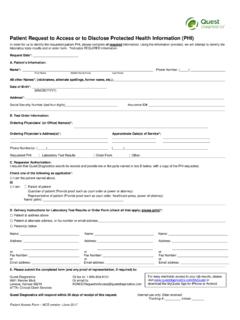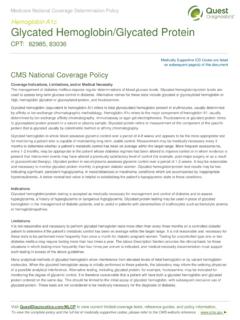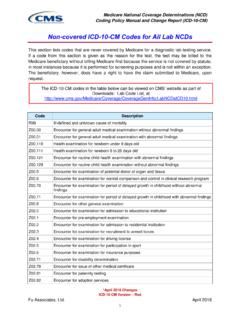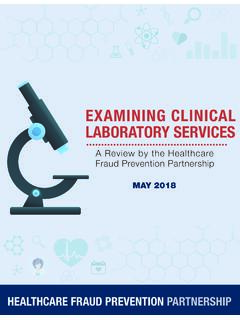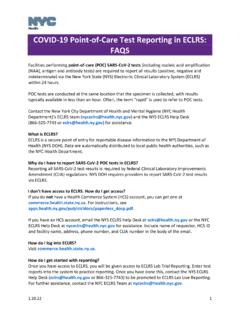Transcription of 70% of medical decisions are based on lab results
1 Professional Laboratory Services 70% of medical decisions are based on lab results Solutions to optimize operations, improve quality and lower costs at hospital clinical labs Framing the Issue Health care in the United States includes a vast array of complex interrelationships among those who receive, provide and finance care. health care employs 13% of the workforce and has expenditures of approximately $3 trillion or 18% of gross domestic product (GDP).1,2. Due to the economic challenges, costs and eliminating redundancies Therefore, ongoing investment in the rising cost of health care is a are the top priorities for hospitals and the hospital laboratory is crucial major issue for patients, employers, health systems.
2 Within the hospital, as it allows: providers and payers. The desire clinical labs are being impacted on to reduce cost and increase quality two fronts. On the inpatient side, 1. Quality of testing is forcing health care to move from Medicare payment pressures are 2. Operational efficiencies a fee-for-service to value- based forcing labs to cut expenses. On 3. Access to the latest outcome model, where payments the outpatient side, clinical labs are diagnostics testing will be constrained and subjected confronting fee schedule reductions, and services to increased transparency.
3 The a new bundled payment system culmination of all these changes is and uncertainty about Medicare 4. Patient safety having an adverse impact on the reimbursement rates. 3. In order to demonstrate value from bottom line of many hospitals and Laboratory testing plays a crucial their labs, and remain profitable, health systems across the country. role in the detection, diagnosis and hospitals are partnering with Given the pressure resulting from treatment of disease in patients. national clinical laboratories which declining reimbursements, reducing An estimated 70% of all decisions can drive operational efficiencies regarding a patient's diagnosis and and cost savings.
4 National treatment, hospital admission and laboratories like Quest Diagnostics discharge are based on laboratory offer solutions ranging from test results . As health care reform reducing costs through laboratory focuses on diagnosis and early management to enabling deeper intervention, timely and accurate lab clinical capabilities through analysis results are necessary for the quality and management of test utilization. of patient care and for managing downstream costs. 2. Reducing Costs Through Hospital Laboratory Management Although some larger systems Table 1: H.
5 Ow hospitals can benefit from working with national have modernized their laboratory clinical laboratories operations and built centralized core-labs, the majority of Problem Solution hospitals and hospital systems High costs due to limited Cost reduction by benefiting from nationwide are still not operating purchasing scale economies large purchasing scale economies at optimum capacity and output. and fluctuating testing volumes and moving testing from a variable Quest Diagnostics offers hospitals cost to fixed cost laboratory management solutions Periodic investment needed Purchasing of laboratory equipment that are designed to lower cost, for latest equipment upkeep managed by Quest Diagnostics, reduce capital investment.
6 Improve and purchases thereby providing hospital with operational efficiencies and deliver access to the most sophisticated quality patient care and service and latest testing capabilities. (Table 1). This also liberates capital which can be invested elsewhere Today, hospitals spend on average Subpar operational Improved laboratory operational 3-4% of their net patient revenue efficiencies due to lack of efficiencies, such as reducing lab real on clinical laboratory services. standardized processes estate footprint thereby reclaiming For mid-size 300-500 bed hospitals valuable space which can be with annual net patient revenue allocated elsewhere of approximately $300 million, Limited quality tracking Advanced quality measurement.
7 Contracting with a national diagnostic and improvement metrics analysis and tracking metrics through testing laboratory could reduce the implementation of clinical lab best laboratory spend up to 20% or $2 practices at the hospital lab million annually (Figure 1). However, Staffing shortages of skilled Lab employees managed and as the scale and scope of the technicians, phlebotomists employed by Quest Diagnostics operation increases, as in the case and medical directors of larger hospital systems, greater Inability to effectively and Access to advanced connectivity savings could be realized annually.
8 Accurately report due to fragmented solutions and data driven and uncoordinated IT systems diagnostic insights Figure 1: Cost savings through laboratory management Cost savings for a typical 400 bed hospital How will this be realized? ~$10M ~$2M Leverage purchasing economies Equipment Supply cost ~$8M Eliminate future CapEx Reduce administrative support costs Optimize site testing location Up to 20%. Labor Free up physical space overall cost savings Increase productivity Before After 70% of medical decisions are based on lab results 3.
9 Eliminating Redundancies Through Network Optimization The last few years have seen an increase in the number of mergers and acquisitions of hospitals and hospital systems. High levels of consolidation activity are likely to continue, driven by the need to integrate clinically, manage costs and prepare for the shift from volume to value- based However, when hospitals consolidate they introduce redundancies and subpar operational efficiencies due to lack of standardized processes. By working with national laboratories such as Quest Diagnostics to manage and optimize their lab testing network, hospital systems can address these redundancies, reduce costs and continue to deliver high quality patient care, as shown in Table 2.
10 Table 2: How hospitals can benefit by optimizing laboratory operations Problem Benefit from a Clinical Lab Partner Multiple testing sites onsolidation of testing sites based on key business factors such as logistical C. complexity, potential savings, turnaround times, purchasing costs and ease of implementation Frees up valuable real estate which can be used elsewhere Duplicated services Optimization of operations ensures streamlining and eliminates duplication of services Subpar test volumes Consolidation allows for testing volume to be driven to fewer hospital labs Ad hoc test menu Standardized and latest test menu available throughout the hospital network, thus allowing better.
